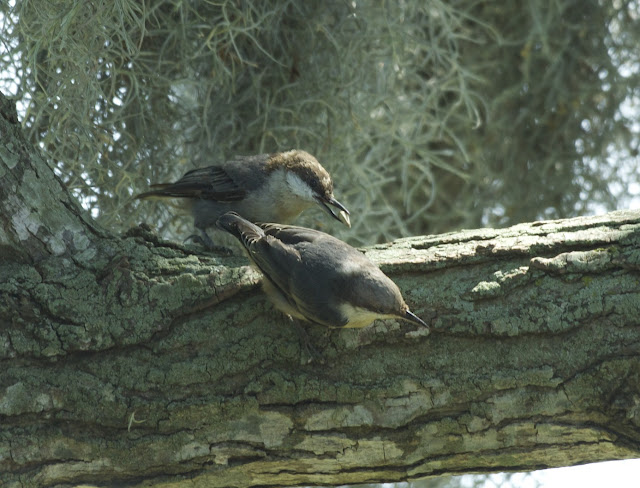It is good to have a home away from home. Who doesn't want to have more homes? A diversity of domiciles? A collection of camps? A bricolage of bases? In this day and age, with Air BnB and relatively cheap travel, Cabin Fever is a preventable disease.
Team Butler's Birds recenty spent a weekend at Chocowinity Bay, where the Pamlico River and its tributaries are leave their offerings to the broken beginnings of the Atlantic.
The small and tidy Goose Creek State Park is a nifty nearby hotspot, where you can find quarantined graveyards for victims of early 1800s Yellow Fever, pay-phones in the woods, and pretty good birds. It should be said that I have never seen any Geese at this creek, however a Carolina Wren does live in the entrance signage.

Ovenbird is one of the reliable species at GCSP. Fond of woodlands with decent undergrowth, they're vocal and visible around every trailhead it seems.



The brackish coastal portion of the park provides the greatest sense of potential, but also disappointment so far. It seems like a great spot for Rails and Sparrows, but other than an occasional fly-by Tern I have not had any birds of note in this area.

Partially I blame circumstances; it is the farthest corner of the park and the park doesn't open until 8am (!!!), so I'm not flogging the bushes until 8:30am, but I still can't shake the sense I am doing something wrong with this opportunity. Birders...know the feeling?

Did you know Purple Martins will repurpose old Osprey nests? You didn't? Me either. Because they don't. They're just perched nearby. Don't jump to conclusions.
Every time I have visited the GCSP I have hustled, even bustled, to the corner of brackish inlets, like a child running downstair at Christmas, eager and excited. Like the same child whose parents pawned their respective hair and watch-bands to buy each other gifts and forgot about me entirely, I am continually disappointed and left without. However it's a quick rebound, because GCSP also provides a constant of satisfaction with its boardwalk.
During the most recent visit, looking for my customary recovery after my customary disappointment, the boardwalk was particularly good, no Magee Marsh or Anahuac, but excellent to scale. Even without birds, the herps are great and it is surprisingly not buggy, actually less so than the woods.


A buzzy NOPA was yelling into the void right at the start where the lichenous boardwalk runs aground. Parulas are typically gregarious, but after checking me out for a minute, perhaps staring into my bird-lusting soul and sensing the emptiness, things got beyond cozy.


This NOPA had no filters, no scruples, and no sense of personal space. It became my favorite ever individual NOPA. May the gods have mercy on my soul for the crushing I did to it this day.






Portions of the boardwalk are closely hedged in with thick scrub, while others are shaded over with towering mossy oaks and cypress. In between are openings where storms raged through and snapped everything off at a certain height, leaving many convenient pedestals for swampy birds one might expect.
Green Herons here are very sensitive, and will flush from their conspicuous perches, loudly and with great complaining, no matter how careful one is. Green Heron in NC is a bird of righteous indignation. I am still used to pond-loving Green Herons in Phoenix, which were largely inured to people and highly crushable.


Bluebirds and Cardinals also enjoy the open perches, and apparently disregard any notions of compartmentalized aesthetics. They seemed out of place.
For shame generic passerines, you are not of the swamps, but of the yards, lawns, and fences.


Possessing both strong aesthetics and habitat integrity, the Prothonotary Warbler is boardwalk perfection.


There was a family group of 3 birds foraging back and forth across swamp. Too good. The GCSP boardwalk is the best place I know of for crushing Proths, and by extension it is the best place for crushing Proths that are crushing moths...or dragonflies, etc.

I was also treated to the thick and resonant percussion of a Pileated trifecta. Upon hearing the unmistakably drumming I waited with uncharacteristic patience until they worked their way closer to the boardwalk. Large, powerful, transitionally ornithischian...Pileated Woodpeckers have a powerful impact on trees and people alike.


I know PIWOs inhabited/inhabit areas that Ivory-billed could not, as well as similar old swamp. It's still curious to me that Ivory-bills are all but gone entirely and Pileated are doing decently well. Is that because most swamplands now are the result of preservation since the 1960s, after it was too late for IBWOs? Did IBWOs have other reproductive difficulties? Why didn't Teddy Roosevelt save them?
With crushy Warblers, big Woodpeckers, a snapping turtle, anoles, and other goodies, the boardwalk at GCSP is it's own micro hotspot. With the exception of a few migrants, the expected species here is pretty set and limited, but until I can get the skills and strategy up to par for other habitats of potential, it's Boardwalk 4 Tha Win.






















